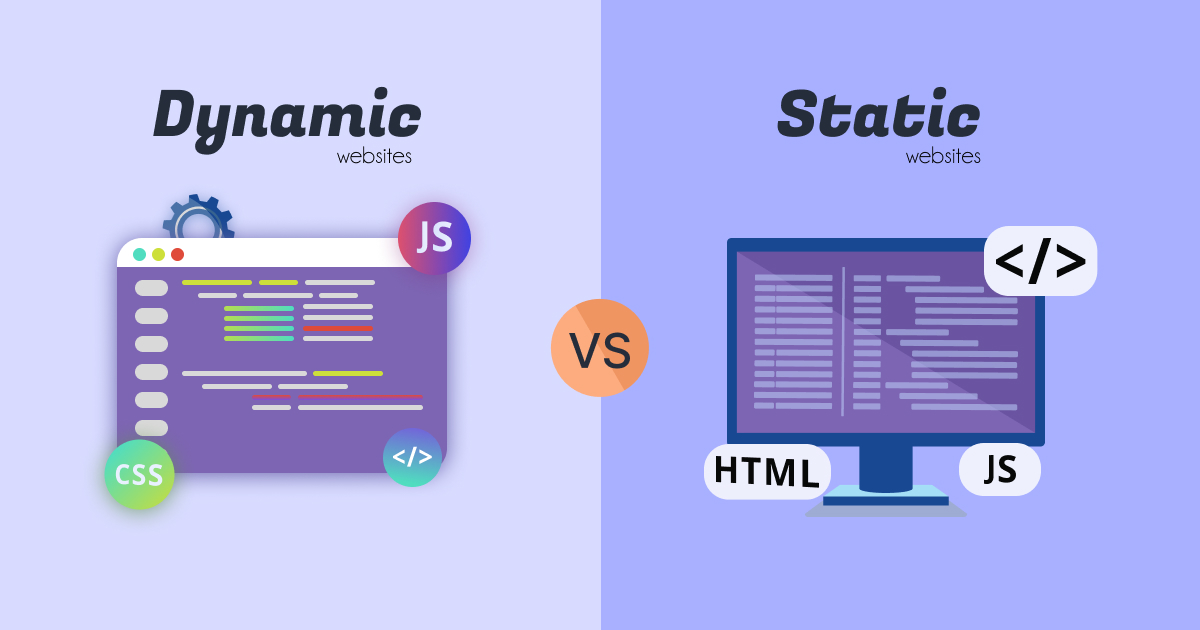
Static vs. Dynamic Website: What Are They and Which One Does Your Business Need?
Let us know what you think
Leave a messageWhile researching website design and development you will almost certainly come across 2 words which describe different types of website you can build, static and dynamic. Choosing between these is one of the first - and most important - decisions that will determine how your website will function, but what are they? How do they differ? This post has been written to outline the difference between static and dynamic websites, as well as guiding you on which may best serve your needs.
Static Websites
What is a Static Website?
Static websites are the original, and most simple websites. They are fixed, meaning every visitor will see the same thing, every time they visit the same pages. ‘These websites are built using HTML, CSS, and these days almost every website uses JavaScript to some degree for added functionality and features. Static websites are the easiest and cheapest to build and host.
How Static Websites Work Under the Hood
During the creation of the website files were coded - by hand or by software - outlining what will be contained in each page of the website. An HTML file defines the content of the site, a CSS file adds styles, positioning and animations, and JavaScript adds the ability to add more complex and interactive components and elements, even allowing for games, artificial intelligence, design software and more to be run inside a user’s browser. When a user requests a page (by typing in the URL or clicking a link to the page) the server sends these files over to the user’s browser, which then displays the content exactly as it was made.
Example Uses of Static Websites
Static websites, despite their relative simplicity, can be used for many different purposes, here are a few of the most common: Personal blogs Small business sites (such as our own here at Arctic Hare Design) Portfolio websites Informational websites
Advantages of Static Websites
Speed
Static websites are the fastest-loading websites for the user, and as such have the best user experience in terms of speed Due to the fact that there is no processing or editing required by a server the files can be sent immediately upon request from the server. This can make a website feel more responsive and improve user satisfaction.
Security
In comparison to dynamic websites, static websites offer higher security. This is due to the fact that there is no reliance on server-side processing or databases, meaning there are far fewer entry points for hackers to gain access.
Cost-Effective
Creating and maintaining a static website is generally less costly than its dynamic counterpart. A static website requires no database setup or maintenance, backend code to be written, or server-side infrastructure. This means that the initial development of the website requires less work and therefore less cost, as well as making far cheaper hosting options available to the website owner.
Reliability
Static websites are inherently more reliable than dynamic websites. Due to their simplicity and the lack of server-side processing there is a lot less that can go wrong, resulting in a more robust website that requires less troubleshooting and maintenance.
Downsides of Static Websites
Limited Interactivity and Functionality
Due to the lack of backend databases or server-side code, the scope of a static website will always be limited. Without these technologies it is impossible to have sites that allow user login, tailored user experiences or dynamic content updates. Features such as these all take place within the server-side processing of a dynamic website.
Updating Content is More Complicated
A dynamic website will often make use of a CMS (Content Management System). This can take the form of software such as WordPress or Webflow, or it may be created by the development team during the creation of the website for a more tailored solution. Without any form of CMS the only way to update or add pages to a static website is through direct modification of the HTML, CSS and JavaScript source files, meaning a developer or other person familiar with these technologies is required every time an update to the website must be made.
##Dynamic Websites
What is a Dynamic Website?
A dynamic website generates pages or other content elements on-the-fly. This means that server-side languages such as Python, PHP, Ruby or JavaScript (using NodeJS) are used to process the content before sending it to the user’s browser. This can include things such as fetching information from a database or processing data.
How Dynamic Websites Work
Dynamic websites rely on server-side code to generate the HTML files that are sent to the user’s browser. Instead of having a pre-made HTML file which always contains the same content, a dynamic website will have templates for pages which are then filled with content through database queries by the server-side script. This allows for the pages to retain their structure while displaying different content as needed.
Example Uses of Dynamic Websites
E-commerce sites News sites Social networks Video Streaming sites
Examples of Dynamic Websites
Most websites you use regularly are more than likely dynamic, here are a few examples of extremely well-known dynamic websites:
- Amazon
- YouTube
- Netflix
Advantages of Dynamic Websites
Highly Interactive and Customisable
Dynamic websites make it possible to alter the content shown to each user each time they load the page. This means you can show users products that will most appeal to them and only show information to certain users based on their login status. This level of personalisation can greatly improve both user experience and conversion rate by making the website more tailored and relevant to individual users’ needs.
Easy Content Management
Many dynamic websites use a CMS (Content Management System), streamlining the process of adding or managing the website’s content. This can range from adding or removing products to writing new blog posts or articles. Such changes do not require editing HTML files as the dynamic website can use information from the database to fill out page templates.
Real-time Data Processing
Using a dynamic website it is possible to implement features such as live updates and interactive dashboards. This allows you to provide the most up to date information to the users, and allows the users to search or filter what they would like to see from large sets of data. This is essential for use-cases such as news portals or social media networks, with constant addition and removal of content.
Disadvantages of Dynamic Websites
Slower Loading Times
Due to the need to process the information and create the HTML documents on the server side before sending them to the user, dynamic websites are almost always slower than a well coded static website. This can often be offset with efficient code such that a good user experience can be maintained, but they will never match the speed of static websites, and creating fast code that can run on large scales can be complex, expensive and require more maintenance.
More Complex to Develop and Maintain
As brushed upon in the last point, the creation and maintenance of a dynamic website - particularly a complex web application - can be difficult and expensive. This is due to increased need for code writing, code testing, security considerations and troubleshooting. Simply put, a dynamic website has more potential failure points than a static one, meaning a solid end product that works as expected will take more effort and expense.
Greater Security Risk
Due to the increased complexity and the amount of data stored on a dynamic website, hacking is both easier and more rewarding for potential intruders. Dynamic websites often store databases of sensitive information about users or the business, and the server-side code can be a weak point if improperly implemented. In addition continual maintenance will be required as new vulnerabilities are exposed in existing systems. Good practices and safe code can make a dynamic website very secure, but the security risks are never gone completely.
Key Differences Between Static and Dynamic Websites
We have now gone through both static and dynamic websites, and explained what each can and can’t do. Before discussing whether your business needs a static or dynamic website, here is a quick summary of the key differences between the 2:
Content Management
Static Websites
Content is fixed and making changes or updates requires direct, manual updates to the HTML files.
Dynamic Websites
Content can be managed using a Content Management System - existing or tailor made - or other backend interfaces.
Performance and Speed
Static Websites
Fastest loading times due to direct file serving.
Dynamic Websites
Slower loading times due to requirement of server-side processing
User Interaction
Static Websites
Limited interactivity, pages will be the same upon each new visit
Dynamic websites
Highly interactive, can display different and personalised information depending on factors such as user login or browsing patterns
Development and Maintenance
Static Websites
Easier to develop and maintain, most suited for information websites or smaller projects.
Dynamic Websites
More complex development and maintenance, most suited projects requiring user interactivity or larger projects
Which One Do You Need?
Whether the best choice for you is a static or dynamic website depends on your needs. Here are a couple of factors:
Purpose
The purpose of your website, and what features you want to offer, are the number one factor when choosing between static or dynamic websites. If your website is primarily for displaying information which you won’t edit or add to often, and it doesn’t need functions such as logins or targeted product placements, then a static website may be the best choice for you. However, if you would like to sell products, allow users to login, post content or search for content, or if you would like to have a complex web application then you will need the extra functionality offered by a dynamic website.
Scalability
If you anticipate your website will, now or in the future, require content updates, e-commerce capabilities, user interaction or more complex features, then opting for a dynamic website from the start may make more sense and save headaches further down the line.
Budget
Your budget will greatly affect which type of website is right for you. Static websites tend to be more inexpensive to develop and maintain, while dynamic websites can be more complex and costly. If your project is mainly to have a simple online presence and display information about your business and what you do, then a static website might be the right choice for you.
Conclusion
In summary, your specific needs and use case define what type of website you will need. Static websites are ideal for simpler sites with limited interactivity, while dynamic sites are more well-suited to larger and more complex applications with content updates. To make the choice you should assess your project needs, requirements and budget.
If you are still unsure which is best for you, get in touch! Our team is here to guide you and assist you through each step of the process, now and in the future. [Contact us] (contact) today, and we can get started on your web development journey!
